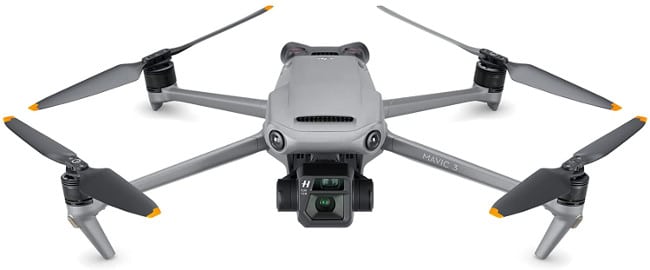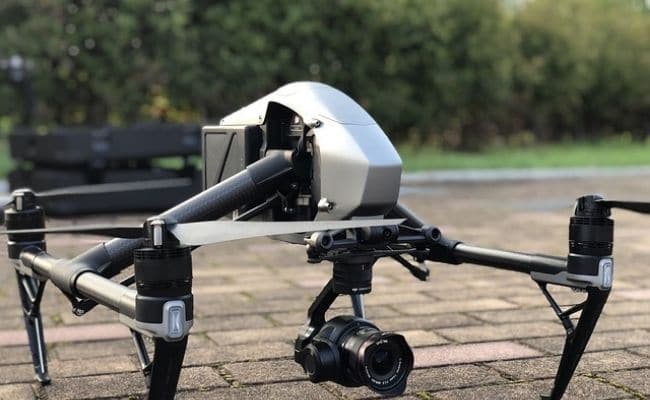So, you’re looking to buy a drone for photography and you’re looking at the differences between the DJI Mavic 3 vs Inspire 2. In this comprehensive article, we will compare and analyse the key features of both drones in order to help make the decision easier for you. So, if you want to know everything there is to know about these two drones, keep reading!
Both are flagship drones from DJI and come with most of their innovative features, thanks to their advanced flight technology, these drones are relatively easy to operate even for beginners.
Something you may be aware of is that DJI recently announced that they will stop production of the Inspire 2, however, they will still continue supporting drones via firmware updates and offering technical support.
The table below highlights the main features of each drone, as you can see, while the Mavic 3 comes out on top of features like flight time, range and intelligent features, the Inspire 2 with the Zenmuse X7 camera outperforms the Mavic 3 where it matters for photographers.
DJI Mavic 3 vs Inspire 2 – Camera
The first thing most people will look at when comparing drones for photography is their respective cameras.
The DJI Inspire 2 s compatible with a number of cameras, however, DJI has discontinued most of them apart from the X5S and the X7. The X5S is similar to the camera on the Mavic 3 as they both come equipped with an MFT sensor. The X7 is undoubtedly the superior camera with its larger sensor, a mechanical gimbal, interchangeable prime lens and ability to record video footage in 6K RAW and capture images in 24MP.
In this article, I will compare the X7 and X5S against the Mavic 3 MFT camera.
The Zenmuse X7 Camera is a high-performance, compact camera that has been designed to meet the needs of professional cinematographers and aerial photographers.
The X7 brings together DJI’s years of expertise in aerial imaging into one powerful yet portable device.
The Zenmuse X7 is DJI’s first camera that comes with a Super 35 sensor for video recording. This camera has been engineered specifically for aerial cinematography, it has the capability to record in 6K CinemaDNG or 5.2K Apple ProRes at 30fps and 3.9K CinemaDNG and 2.7K Apple ProRes at 59.94fps.
With a 24MP APS-C type sensor and 14 stops of dynamic range, the camera is able to persevere more data in low-light and bright conditions which will help produce accurate colour details in post-processing.
DJI also introduced their DJI Cinema Colour System (DCCS) with the Zenmuse X7 which features their own D-log and D- Gamut colour profiles for higher dynamic range and enhanced colour output. Combined with the Inspire 2 CineCore 2.1 processing system with Its 15-stops of dynamic range, this camera can preserve more data in highlights and shadows allowing for more creative freedom in post-processing.
The CineCore 2.1 incorporates improved colour technology that will allow cinematographers to record video footage that is suitable for professional use in movies, tv and documentaries.
Using advanced technology, the Zenmuse X7 uses a lens mount system specifically for this camera. The innovative design of the DJI-DL mount means that the flange focal distance is less than 17mm, allows more light to hit the sensor and reduces the overall of the camera. There are 4 prime lenses from DJI that are compatible with the X7, they have focal lengths of 16mm, 24mm, 35mm and 50mm, f/2.8-f/16 variable aperture, the smallest lens has an ND filter while the other three have leaf shutters.
The camera is stabilised by a 3-axis mechanical gimbal that provides a wide range of viewing angles through its tilt, pitch and pan motions.
The Zenmuse X5S has a smaller MFT sensor but also comes with an interchangeable lens, both prime and variable focus. It’s stabilised by a 3-axis mechanical gimbal similar to that of the X7 and much superior to the Mavic 3.
Using the CineCore 2.1 image engine on the Inspire 2 the X5S can record cinematic video footage 5.2K at 30fps in both CinemaDNG and Apple ProRes formats.
It can also record 4k video footage at 60fps at 100Mbps in H.264 and comes 12.8 stops of dynamic range.
The X5S captures images in 20MP and has several photography modes including burst shooting at 20fps in DNG RAW.
The Mavic 3 comes with a dual-camera system, the main camera has a micro 4/3 sensor and there is a telephoto camera on top that is fitted with a 162mm prime lens and comes with a 28× hybrid zoom.
Although the specs are not as good as the X7 or X5S, it is still a very impressive camera, especially for a compact foldable drone like the Mavic 3.
The camera supports recording video footage in H.264/H.265 and Apple ProRes 422HQ with the Cine Version.
It can record video footage in 5.1K at 50fps and DCI 4K at 120fps in both Apple ProRes and H.264/H.265.
The camera can in 10-bit D-log for HDR videos and coms with 12.8 stops of dynamic range, which will capture more data in the shadows and highlights.
The camera was engineered jointly with Hasselblad and comes with Hasselblad’s patented natural colour technology.
With this colour technology, the camera can record accurate colour details and produce vibrant images with true colour accuracy.
The telephoto camera can capture images in 12MP and also record 4k videos, however, the main function of this camera is for scouting purposes.
One thing to take into consideration is the storage situation for each drone, especially if you want to record in Apple ProRes format.
The Cine version of the Mavic 3 comes with an internal 1TB SSD device for recording video footage in Apple ProRes 422 HQ and for other video formats there is an external storage solution that can take a maximum memory card of 512GB.
The Inspire 2 has a micro SD card slot that has a maximum capacity of 128GB and an SSD card slot on the back and there are memory capacities of 120GB, 240GB, 480GB and 960GB. For these cards, you will need a compatible CINESSD station to transfer your files to your computer, laptop or tablet.
Mavic 3 vs Inspire 2 – Design
I have personally always preferred the compact foldable design feature of the Mavic drones and the Mavic 3 is no different.
The Mavic 3 weighs under 900g, with the Cine version being around 4g heavier than the standard version. In its unfolded form it has a diagonal length of 380.1 mm, in its folded form, it will easily fit into your rucksack and is a fantastic drone to travel around with, so if you move around a lot, this is the perfect drone for you.
The Inspire 2 on the other hand is a beast of a drone, it looks very futuristic, it has a grey/black colour scheme, and the main body looks like the head of one of the xenomorphs from the alien’s movie.
The propeller arms and legs move up when in flight and come back down during landing mode. The maximum weight capacity of this drone is 4.25kg and its size and weight provide it with good resistance to windy conditions. There is a small FPV camera on its nose that can help the pilot navigate while the main camera focuses on the action.
The Inspire 2 also comes with multiple redundancy systems for minimal risk during flight operations. It has dual battery compartments, dual IMU and barometer and comes with sensors on the top, front and back for a 3-way obstacle avoidance system.
The Mavic 3 comes with DJI’s latest obstacle avoidance system, it’s Omnidirectional and can avoid obstacles in dense areas.
The controller for the Inspire 2 uses DJI’s Lightbridge transmission technology, it has a range of 7km, and the live video feed is streamed in HD with low latency. For FPV and to access the drone’s advanced features, you will need to download the DJI GO 4 App. The Inspire 2 is also compatible with DJI CrystalSky controllers, these have the added benefit of having a large screen with high luminance and so you do not need a tablet or smartphone.
The Mavic 3 comes with an RC-N1 controller as standard or the RC Pro controller with the Cine version. The main difference between the two controllers is the large screen on the Pro version. The Mavic 3 comes with DJI’s latest transmission system, OcuSync 3.0 which allows for a transmission range of 15KM.
Like most of DJI’s newer consumer models, the Mavic 3 uses the DJI Fly App for FPV and access to the advanced features of the drone.
These long transmission ranges shouldn’t really affect which drone you purchase unless you have permission to operate drones beyond the visual line of sight (Bvlos).
DJI Mavic 3 vs Inspire 2 – Flight Time
The Mavic 3 is powered by a lithium polymer intelligent battery that provides it with an official flight time of 46 minutes. This is the longest flight time for any of DJI’s prosumer drones and although people will not achieve that time in real life, most people will manage 40+ minutes which is still very good.
The Inspire 2 is also powered by a similar type of intelligent battery but because of its size and the size of its payload, it can manage between 23-27 minutes. With the X5S camera, the drone has a flight time of 23 minutes and with the X7 it is 27 minutes, although, most people will probably get some a little south of those official numbers.
This is why it’s always advised to purchase at least an extra battery to extend the flight time.
Advanced Features
Both drones are equipped with many of DJI’s innovative features, they come with several autonomous flight modes, although the Mavic 3 comes with the latest version of these modes.
The Mavic 3 and Inspire 2 come with an automatic return to home feature, the Mavic 3 comes with a more advanced version of this autonomous flight mode. Once the mode is activated, the Mavic 3 will calculate the shortest path to the return home point and take that route.
The Inspire 2 has dual redundancy of its main modules like the battery, IMU and barometer, so should any of these components should fail during flight, it will have minimal effect on the mission, this is something that the Mavic 3 is not equipped with.
The Mavic 3 comes with 2 intelligent flight modes called Mastershots and QuickShots, these allow creators to shoot and record high-quality video footage from different angles completely autonomously.
Alternatives
Both drones are geared towards professional photographers and cinematographers, however, they are expensive pieces of equipment and not everyone will have the budget to purchase either one.
There are very good alternatives that may not provide the creative flexibility of the Mavic 3 or Inspire 2 but they certainly can produce professional quality images and videos.
The two best alternatives would be the DJI Mavic 2 Pro and my personal favourite the DJI Mavic Air 2S.
The Air 2S is an amazing drone that comes with a 1-inch 20MP sensor with a 22mm focal length and 88° FOV. It comes with many intelligent features, can capture HDR videos with its 10-bit D-log colour profile and has 31 minutes of flight time and costs less than $1000. Although most people opt to purchase the combo version which is around $1300.
Final Thoughts
The Mavic 3 and Inspire 2 are drones for the professional creator, whether you are filming a commercial, movie, documentary or any other type of video that requires aerial cinematography, these drones are more than capable of producing videos for professional use. However, these drones have other uses, for example, because of their high-end cameras, these drones can be used for photogrammetry and surveillance purposes.



